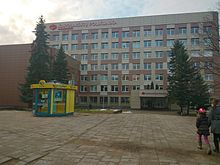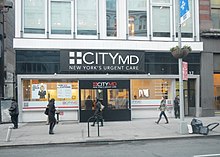
Ambulatory care or outpatient care is medical care provided on an outpatient basis, including diagnosis, observation, consultation, treatment, intervention, and rehabilitation services. This care can include advanced medical technology and procedures even when provided outside of hospitals.
Health care in Ireland is delivered through public and private healthcare. The public health care system is governed by the Health Act 2004, which established a new body to be responsible for providing health and personal social services to everyone living in Ireland – the Health Service Executive. The new national health service came into being officially on 1 January 2005; however the new structures are currently in the process of being established as the reform programme continues. In addition to the public-sector, there is also a large private healthcare market.
Allied health professions (AHPs) are a group of health care professions that provide a range of diagnostic, technical, therapeutic, and support services in connection with health care, and which are distinct from the fields of dentistry, optometry, medicine, nursing and pharmacy.

Singapore Health Services, commonly known as SingHealth, is the largest group of healthcare institutions in Singapore. Established in 2000, the group consists of four public hospitals, three community hospitals, five national specialty centres and a network of eight polyclinics. The Singapore General Hospital (SGH) is the largest hospital in the group and serves as the flagship hospital for the cluster.
Polyclinics in England were intended to offer a greater range of services than were offered by current general practitioner (GP) practices and local health centres. In addition to traditional GP services they would offer extended urgent care, healthy living services, community mental health services and social care, whilst being more accessible and less medicalised than hospitals. A variety of models were proposed, ranging from networks of existing clinics to larger premises with several colocated general practitioner (GP) practices, more extensive facilities and additional services provided by allied healthcare professionals.
A public hospital, or government hospital, is a hospital which is government owned and is fully funded by the government and operates solely off the money that is collected from taxpayers to fund healthcare initiatives. In almost all the developed countries but the United States of America, and in most of the developing countries, this type of hospital provides medical care free of charge to patients, covering expenses and wages by government reimbursement.

A house call is medical consultation performed by a doctor or other healthcare professionals visiting the home of a patient or client, instead of the patient visiting the doctor's clinic or hospital. In some locations, families used to pay dues to a particular practice to underwrite house calls.

The National Healthcare Group (NHG) is a group of healthcare institutions located in Singapore. The group was formed in 2000 and operates several hospitals, national specialty centers and polyclinics. Tan Tock Seng Hospital is the largest hospital in the group and serves as the flagship hospital for the cluster.
Spartanburg Regional Healthcare System(SRHS) is one of South Carolina's largest healthcare systems. SRHS draws patients primarily from the areas of Spartanburg, Cherokee, Union, and Greenville counties (all located in the Piedmont region of South Carolina), as well as Rutherford and Polk counties (located in western North Carolina). Spartanburg General Hospital was organized under the authority of the South Carolina General Assembly in 1917. It officially became the Spartanburg Regional Health Services District, Inc., a political subdivision of the State of South Carolina, by the charter granted by the Secretary of State of South Carolina on May 1, 1995.

Healthcare in Malaysia is mainly under the Ministry of Health. Malaysia generally has an efficient and widespread system of health care, operating a two-tier health care system consisting of both a government base universal healthcare system and a co-existing private healthcare system. While there is a universal healthcare system, specialist services require queuing despite being free. Hence the private health care plays a major role in providing specialist services which complements the universal health care.

The Healthcare in Kazakhstan is a post-Soviet healthcare system under reform. The World Health Organization (WHO), in 2000, ranked the Kazakhstan's healthcare system as the 64th in overall performance, and 135th by overall level of health.
Ambulatory care nursing is the nursing care of patients who receive treatment on an outpatient basis, ie they do not require admission to a hospital for an overnight stay. Ambulatory care includes those clinical, organizational and professional activities engaged in by registered nurses with and for individuals, groups, and populations who seek assistance with improving health and/or seek care for health-related problems. The American Academy of Ambulatory Care Nursing (AAACN) describes ambulatory care nursing as a comprehensive practice which is built on a broad knowledge base of nursing and health sciences, and applies clinical expertise rooted in the nursing process.

Virtua Health is an academic non-profit healthcare system in southern New Jersey that operates a network of hospitals, surgery centers, physician practices, and more. Virtua is South Jersey's largest health care provider. The main headquarters are located in Marlton.

A health facility is, in general, any location where healthcare is provided. Health facilities range from small clinics and doctor's offices to urgent care centers and large hospitals with elaborate emergency rooms and trauma centers. The number and quality of health facilities in a country or region is one common measure of that area's prosperity and quality of life. In many countries, health facilities are regulated to some extent by law; licensing by a regulatory agency is often required before a facility may open for business. Health facilities may be owned and operated by for-profit businesses, non-profit organizations, governments, and, in some cases, individuals, with proportions varying by country. See also the recent review paper,

A healthcare center, health center, or community health center is one of a network of clinics staffed by a group of general practitioners and nurses providing healthcare services to people in a certain area. Typical services covered are family practice and dental care, but some clinics have expanded greatly and can include internal medicine, pediatric, women’s care, family planning, pharmacy, optometry, laboratory testing, and more. In countries with universal healthcare, most people use the healthcare centers. In countries without universal healthcare, the clients include the uninsured, underinsured, low-income or those living in areas where little access to primary health care is available. In the Central and East Europe, bigger health centers are commonly called policlinics.

Healthcare in Belgium is composed of three parts. Firstly there is a primarily publicly funded healthcare and social security service run by the federal government, which organises and regulates healthcare; independent private/public practitioners, university/semi-private hospitals and care institutions. There are a few private hospitals. Secondly is the insurance coverage provided for patients. Finally, industry coverage; which covers the production and distribution of healthcare products for research and development. The primary aspect of this research is done in universities and hospitals.

The nation of Liechtenstein has a universal health care system with decentralized, free market elements through mandated health insurance coverage for every person residing in the country.

Kuala Lumpur Hospital is the largest Malaysian government-owned public general hospital in Kuala Lumpur, the capital city of Malaysia. Founded in 1870, HKL is a not-for-profit institution and serves as the flagship hospital of the Malaysian public healthcare system. This hospital serves as a tertiary and referral hospital. It is located on 150 acres of prime land in the city with 84 wards and 2,300 beds, making it one of the largest hospitals in the world. More than 90 per cent of the beds in HKL are allocated for subsidized patients, providing access to an internationally established standard of affordable healthcare.
A polyclinic is a clinic or health care facility that provides both general and specialist examinations and treatments for a wide variety of diseases and injuries to outpatients and is usually independent of a hospital. When a polyclinic is so large that it is in fact a hospital, it is also called a general hospital.

Healthcare in Azerbaijan is provided by public and private healthcare institutions and regulated through the Ministry of Healthcare.






















